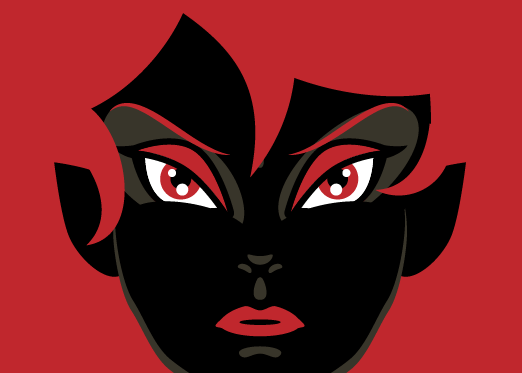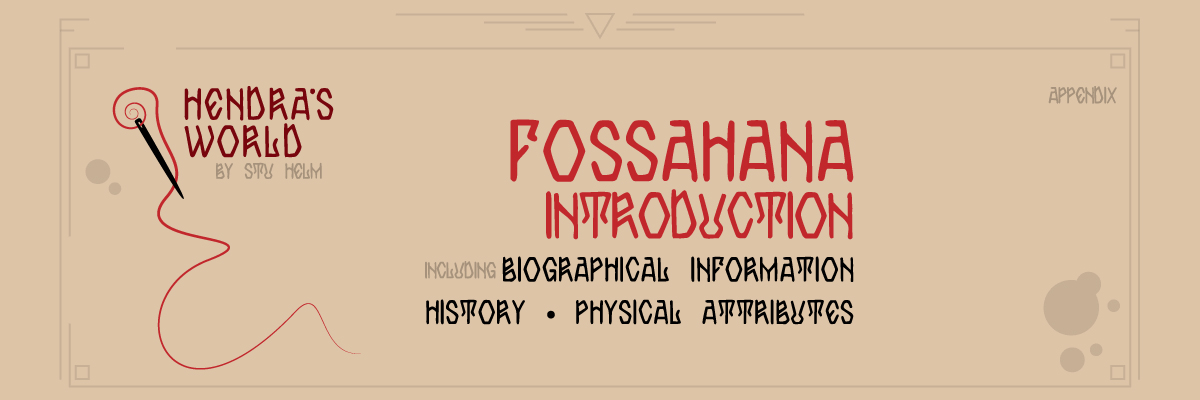Hendra’s World • Appendix
FOSSAHANA
Introduction, History, Physical Attributes etcetera

NAME
Fossahana. Also called Fossi in the diminutive form.
STATS
age: unknown
height: 4’ at shoulder
length: 12‘ nose to tail
weight: >2,000 lbs
children: deceased
house: none
habitat: Hen’lin, D’waiv’lin
Fossahana is a Great Badger, one of a rare species of Mega Fauna in Hendra’s World. She is larger than a bear, though smaller than a beewolf. She is fierce, loyal, loving, and determined. She has been Hendra’s friend and companion for decades, and has gone on many adventures and into many battles with her. Her first litter of 12 pups were eaten by Goblins, and Fossi has never had another, but has instead spent her days and nights by Hendra’s side, hunting Goblins and other evil creatures, keeping Hen’lin safe from invaders, and protecting her beloved Dwarven friends. So few of these once prosperous animals are left in Hendra’s World, that Fossi is the only Great Badger that Hendra has ever seen, in over 200 years of living and traveling all over D’waiv’lin.
Great Badgers have the reputation all over D’waiv’lin of being the most fearless mammals in the world, as well as being the most viscous when attacked, or protecting others from attack.
Though her own children did not survive past infancy, Fossahana helped to raise thousands of Hendra’s sons, as well as her daughter Senhendra, whom she was charged with protecting and comforting as a wee Dwarven baby, when Hendra was unable to, due to wars abroad.
Fossi, like all badgers, is omnivorous and eats everything from elk, rabbits and fish, to tree roots and shrubbery, and she especially loves pumpkins! She does not eat people, or other sentient animals, nor does she like the taste of Goblins, and considers them too foul smelling.
Free Beings
Great Badgers, and other sentient animals are not considered people by Dwarves, and are not officially citizens of any Dwarven country they might live in. They are instead called “Free Beings” and they have their own official status, with documents, such as treaties and bills of rights, that grant them more freedoms than even Dwarves in some cases. They are autonomous, but under the protection of the nearest Dwarven House, as well as all other Houses, up to and including the Grand Maitron of Dwarves, whoever that might be at any given time.
Unlike non-sentient animals, they are neither wild nor domesticated, but exist side-by-side, though apart from the people of Hendra’s world. They may volunteer to fight for one side or another in a conflict, always with their own best interests in mind, although they may also be manipulated, or even enslaved and forced to do the bidding of those with evil intentions.
It is far more likely, however, that these Free Beings will either avoid people all together, or develop strong friendships with them, as is the case with Hendra and Fossahana.
Badgers and House Hen
The Badger, both Great and Lesser, is the symbol of House Hen, the badger’s head, usually in profile silhouette, is the symbol of this mighty House, 2nd only to Hel.
How Big?
One of the largest natural creatures in Hendra’s world, Great Badgers have very few things to fear, and generally enjoy a life free from conflict with other animals, or people, save those listed on this page.
Predators and Enemies
Beewolves will sometimes attack, kill, and eat Great Badgers, and are the only mega fauna large enough to do so, but mostly these two species of great beasts avoid each other.
A lone wyvern is no match for a Great Badger, but a flock of 10 or 12 can attack, kill, and devour one, though not without grievous injuries and loss of life among their numbers, so this also happens rarely.
Würms are the apex predator of the underground, and will hunt Great Badgers in their setts. One large würm (they can grow to be up 30’ in length), can destroy an entire sett, killing, eating, and/or running off the population, and literally bringing the tunnels down.
Goblins hunt, kill, and eat Great Badgers at every opportunity, using crude but effective weapons, and relentless persecution. Goblins often occupy Great Badger cities once they have killed or run off the original occupants.
Humans hunt Great Badgers for sport, and for fur, but do not typically eat them, leaving the flayed bodies behind for jackals, crows, and coyotes to finish off. They are also known to have invaded smaller sets to kill the residents and occupy the tunnels and chambers for themselves.
Q: Do Great Badgers Wear Armor?
A: They can, and they have in the past, but typically they do not. Some of the strengths of any badger, whether Great or Lesser, are their stealth, speed, dexterity, sleekness, and ability to quickly dig and enter holes and tunnels. Armor prohibits all those things. During the final decades of the struggle for dominance over Hel, thousands of Great Badgers were armored and ridden upon by famous Dwarfmaids and Kings into battle, and even Queen Hel XVII herself rode the mighty Paleodahnk many times, both armored and armed, literally to the teeth.
Many Dwarven historians speculate however, that this may have actually contributed to the downfall of Hel, as the heavily armored Great Badger’s were not able to escape from swarms of Gremlins unleashed by The Goblin Ratkings of Bulsh, and were eaten alive inside their shells, dying horribly in large numbers, which resulted in rift between the Dwarves of Hel and their Badger allies, and in the long term, the extreme rarity of Great Badgers, and their near, if not total extinction.
Badger Cities
Great Badgers live in vast underground burrows, or dens, called Setts, Settees, or Cities. A Sett usually consists of a network of enormous tunnels with numerous entrances. The largest setts can have miles of tunnels and as many as 40 openings, and take many decades to complete.
Setts include both large and small chambers used for sleeping, storing food, gathering as a community, and rearing young. These chambers are warm, dry, and comfortable, and always located near fresh surface or ground water.
Disused Great Badger setts, or parts of setts, are often occupied by Dwarves, Humans, Goblins, bears, würms, and other creatures.
Large setts may have hundreds, even thousands of tunnels, rooms, and openings.


